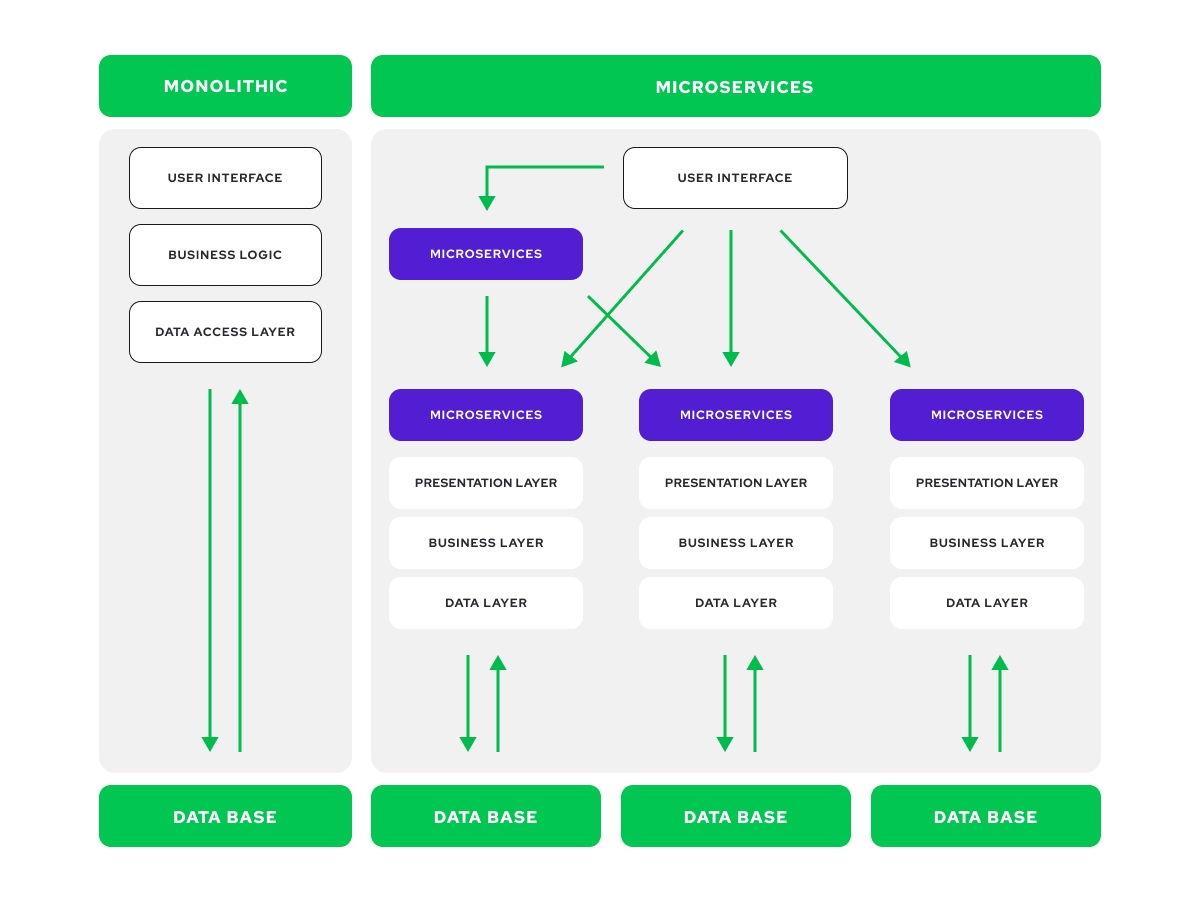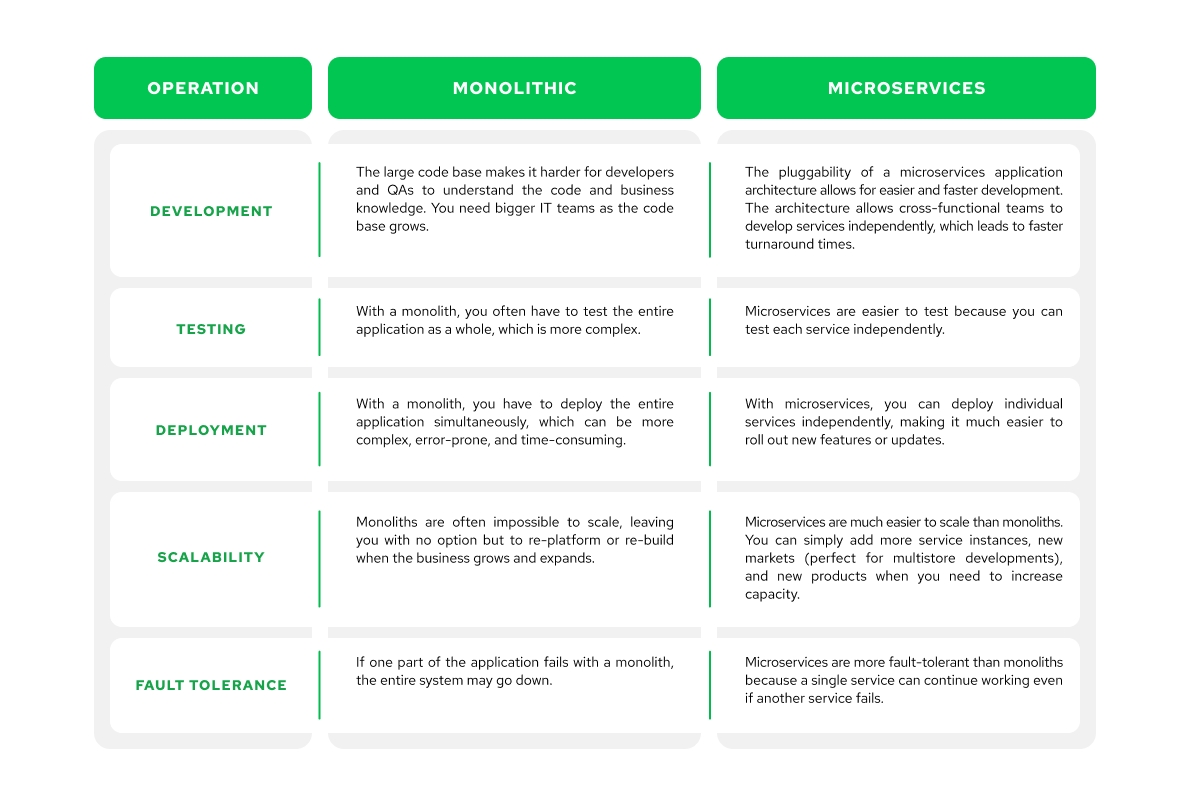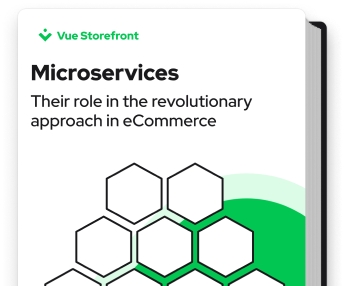Explore by Category:
Microservices
Monolithic vs. microservices: The differences between them and when it’s time to loosen up
Building a new eCommerce store from scratch or changing your tech stack can be a tedious and time-consuming endeavor. That’s why it’s crucial to choose the right solution for your business. Basically, there are two paths you can follow:
- Monolithic
- Microservices-oriented
This blog post will explore the pros and cons of each approach (monolithic vs. microservices-oriented architecture) and help you decide which is best for improving your eCommerce business performance. We’ll also discuss when it might be beneficial to switch from one to the other and how to do it without risk to your daily operations and budget. Yes, it is possible! So let’s jump right in.
Microservices vs. monolithic architecture: Making the right choice
Wisely choosing between a monolithic application or one that leverages a microservices architecture is essential for the future of your eCommerce business. They both offer unique solutions to critical technical and business needs such as:
- Great SEO performance
- Flexibility to change and update features
- Scalability
- High ROI
- Short Time-To-Market
- Agility
These two types of architecture can deliver robust and diverse apps, but their code base and functionality look vastly different, and each serves unique business needs.
The complexity and size of your business will be a significant factor in deciding whether to go with microservices vs. monolithic legacy systems. Your plans for expansion and need to scale are variables that can convince you to start migrating from an all-in-one legacy system to a versatile headless microservices-oriented one.

The differences between microservices and monoliths
Microservices and monoliths are two popular approaches for building online stores. Both have specific benefits, and choosing which to use depends on the project’s particular needs.
Microservices

Microservices have gained unprecedented traction in recent years. This architecture breaks down an eCommerce system into smaller, independent services that communicate with each other via APIs . This approach makes development and deployment more manageable, as each service can be developed and deployed separately.
Using microservices is a modern and practical approach to meeting evolving user needs and experiences that are becoming increasingly important, especially in enterprise projects.
The basic concept is to split up applications into small, self-contained services that can be deployed and updated separately from the rest of the system. This allows for more speed, flexibility, and scalability as they can be deployed on different servers and scaled independently.
Business leaders often raise their concerns that microservices can be more complex to develop and deploy than monolithic applications. Fortunately, this issue is quickly becoming something that is easily addressed. Microservice developers are focusing on performance-oriented software development that aligns with SEO and UX performance metrics and offers customizable OOTB (out-of-the-box) solutions.
Monolithic approach

On the other hand, monolith architecture is a more traditional approach where the entire application is built as a single unit. This can make development and deployment more straightforward, but it also makes the application slower and more challenging to scale.
The main disadvantage of monolithic applications is that they are more complex to update and maintain than microservices. Additionally, because all components are bundled together, it is an almost impossible task to scale individual parts of the application.
Monoliths vs. microservices: Operational differences that impact your eCommerce businesses
So, what are the critical operational differences between microservices and monoliths? Let’s take a look:
Development
- Monolithic
The large code base makes it harder for developers and QAs to understand the code and business knowledge. You need bigger IT teams as the code base grows.
- Microservices
The pluggability of a microservices application architecture allows for easier and faster development. The architecture allows cross-functional teams to develop services independently, which leads to faster turnaround times.
Testing
- Monolithic
With a monolith, you often have to test the entire application as a whole, which is more complex.
- Microservices
Microservices are easier to test because you can test each service independently.
Deployment
- Monolithic
With a monolith, you have to deploy the entire application simultaneously, which can be more complex, error-prone, and time-consuming.
- Microservices
With microservices, you can deploy individual services independently, making it much easier to roll out new features or updates.
Scalability
- Monolithic
Monoliths are often impossible to scale, leaving you with no option but to re-platform or re-build when the business grows and expands.
- Microservices
Microservices are much easier to scale than monoliths. You can simply add more service instances, new markets (perfect for multistore developments), and new products when you need to increase capacity.
Fault tolerance
- Monolithic
If one part of the application fails with a monolith, the entire system may go down.
- Microservices
Microservices are more fault-tolerant than monoliths because a single service can continue working even if another service fails.

Monolith vs. microservices: pros and cons of both architectures
To make an informed business decision about the technology stack you need to drive your eCommerce business into the future, it’s vital to know the facts about your options. In the next section, we analyze both architectures and summarize the following:
- Advantages and disadvantages of monolithic architecture
- Business and technical advantages of microservices
Monolithic architecture: Advantages
These all-in-one solutions tend not only to be more difficult but also brittle. Within this architecture, developers design various layers of functions such as presentation, service, and persistence—and then deploy them as a single jar/war file.
One advantage of monolithic architecture is that it is a robust all-in-one system with a plethora of features. They provide all the components needed for handling business logic, displaying UI layers, managing and publishing content, and more with a single, tightly coupled codebase.
For many years monolith systems represented a seemingly convenient “all-in-one” approach and guaranteed complete control of the system for eCommerce businesses. However, over time, and with rapidly changing user behavior, their drawbacks became a blocker to eCommerce businesses needing to scale and diversify to meet market trends and demands.
In addition, these types of systems make it challenging if you need additional features added post-launch since all changes must go through the codebase itself - braces included.
Monolithic architecture: Disadvantages
Monolithic architecture has distinct disadvantages in the modern eCommerce landscape. It’s vital for eCommerce businesses to fully understand these challenges when making decisions about the future of their eCommerce business.
- A significant downside of monolithic architecture is that it is hard to update and maintain, blocking marketing teams from upgrading a specific product, campaign, or component.
- A centralized architecture does not allow for broader collaboration between independent dev teams. You need larger in-house or subcontractors teams, which affects revenue and ROI.
- You are limited to working with only one technology, which more often than not makes it challenging to integrate with other applications or APIs. This affects UX and performance.
- A bug can potentially crash your entire environment, while it can take weeks to identify and isolate the hot spot as you need to scan hundreds of lines of code. This directly affects your conversion rates and, ultimately, your bottom line.
- Vertical scaling makes monoliths difficult and expensive to scale as additional computational resources are added. This leads to lengthy and costly development cycles.
- Because the whole system is tightly linked, an issue anywhere in the code can take down an entire application, which is detrimental to your daily operations and sales.
When evaluating microservices vs. monolithic on a case-by-case basis, the latter can still be a workable option for meeting the needs of a smaller organization. But only if you’re not planning for expansion into new markets and product lines.
Microservices: Advantages and benefits

Microservices are small application pieces that work together to provide a single service. The architecture comprises these protocols and does not include any heavy lifting like networking or persistence. This means it can be faster for developers interested in building fast, scalable systems with high availability rates.
Microservices offer both business and technical performance-related advantages over traditional monolithic architectures. While some challenges need to be considered when adopting a microservices-based approach, the benefits far outweigh the drawbacks.

Microservice-style applications communicate directly via APIs without going through centralized points. So instead of your app having many different types and sizes of services, each component will only need lightweight libraries provided by their respective vendor frameworks.
This API-first approach is the secret sauce to many of the benefits offered by microservices in terms of performance and scalability:
- An API-first approach makes it easier to integrate third-party applications with your eCommerce system – you can easily plug in and unplug your chosen solutions.
- It makes it easier to scale your eCommerce system, as you can add new functionality by simply adding new APIs.
- This approach makes it easier to test your eCommerce system, as you can test each integration independently.
Microservice architecture is an excellent solution for maintaining data integrity because each microservice has its own database. If one service experiences a problem, other services won’t be affected. This also enables each application to use the database best suited to its needs.

Key microservices principles:
1. They are built around business capabilities: Microservices won’t restrict themselves from adopting appropriate tech stacks or a backend database storage most suitable for solving specific business problems. They can adapt on a per-case basis.
2. They have a single responsibility: This forms a part of the SOLID design pattern. It simplifies any microservice by delivering only one core functionality. So, if you need five functionalities, you need five microservices with five separate databases.
3. They are designed with failure cases in mind: It will not affect the entire system when one microservice goes down. This is a crucial reason why they are increasingly popular in eCommerce businesses. All other functionalities remain intact when one module fails.

Business advantages of microservices vs. monolithic:
- They are easier and more cost-effective to develop and maintain since you need a smaller dev team.
- This directly translates into higher ROI for each component in the tech stack.
- Microservices focus on one function at a time, making it the best it can be, which leads to higher performance and speed.
- Faster performance leads to increased conversion rates.
- They are much more scalable due to individual deployment, allowing your business to grow as rapidly as needed without any technology blockers.
- Microservices architecture supports horizontal scaling, making it quick and seamless.
- Based on your business requirements, you can use different best-of-breed technology for each microservice.
- It is easy to add features since you can implement different business requirements as additional services and loosely couple them. This independence from each other also means that updating any one of them is easier.

Technical advantages of microservices vs. monoliths:
- Less start-up and deployment time is needed.
- Microservices are easy to manage due to their smaller code size.
- It is easier to scale specific services as needed instead of scaling the entire application.
- You only need to redeploy the specific microservice that must be updated.
- Increased agility and flexibility as they allow devs to work on smaller, self-contained units of code. They can iterate on features without completely redeploying the application.
- Onboarding new developers is much easier as they only need to understand a singular microservice providing the functionality he will be working on instead of the entire system.
- It reduces the complexity of the application as it consists of smaller, independent components. It also minimizes the risk of bugs and errors.
- Microservices are easy to test and deploy because it is done independently.
Let’s wrap it up: How to choose the best architecture for your business?
We hope you gained the needed insight into the trending microservices vs. monolithic debate. If you need a scalable, flexible, and modifiable eCommerce system, we can boldly state that a microservices architecture is the best choice for your business.
Share:
Share:
Frequently asked questions
More in Microservices
Ready to dive in? Schedule a demo
Get a live, personalised demo with one of our awesome product specialists.






















